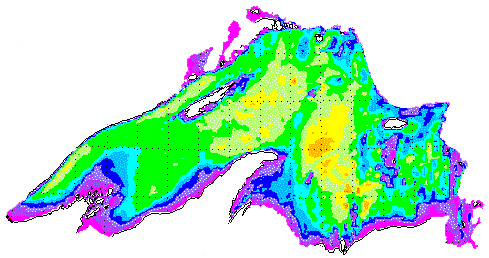 |
|||||
Great Lakes Sea Grant Extension Office
About Our Great Lakes : Lake by Lake Profiles
| Introduction
| Background | Ecology
| Economy Great Lakes Facts | Threats | Lake by Lake Profiles |
||||||||||||||||||||||||||||||||||||||||||||||||||||||||||||||||||||||||||||||||||||||||||||||||||||||||||||||
| |
||||||||||||||||||||||||||||||||||||||||||||||||||||||||||||||||||||||||||||||||||||||||||||||||||||||||||||||
| Length | 350 mi / 563 km |
| Breadth | 160 mi / 257 km |
| Depth | 489 ft / 149 m average |
| Shoreline Length | 2,730 miles / 4393 km (including islands) |
| Volume | 2,935 cubic mi / 12,232 cubic km |
| Water Surface Area | 31,700 square miles / 82,097 square km |
| Retention/Replacement Time | 191 years |
| Outlet | St. Marys River to Lake Huron Levels regulated by international agreements |
| Surface Area in U.S. | 20,598 square miles / 53,350 square km |
| Population | 444,000 U.S. / 229,000 Canada |
| Source: Lake Superior Basin map produced by Michigan Sea Grant/Michigan State University Extension. | |
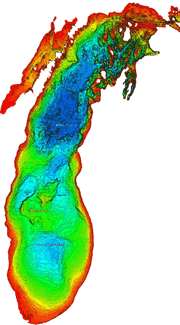
Lake Michigan is the third largest of the Great Lakes and ranks as the fifth largest lake in the world.
Lake Michigan Basin Statistics
| Length | 307 mi / 494 km |
| Breadth | 118 mi /190 km |
| Depth | 279 ft / 85 m average |
| Volume | 1,180 cubic mi / 4,918 cubic km |
| Shoreline Length | 1,640 mi / 2,639 km (including islands) |
| Water Surface Area | 22,300 square mi / 57,753 square km |
| Surface Area in U.S. | 22,300 square mi / 57,753 square km |
| Retention/Replacement Time | 99 years |
| Outlet | Straits of Mackinac to Lake Huron |
| Population | 12,052,743 U.S. |
Source: The Lake Michigan Basin bathymetry map was produced by NOAA (GLERL and National Geophysical Data Center). |
|
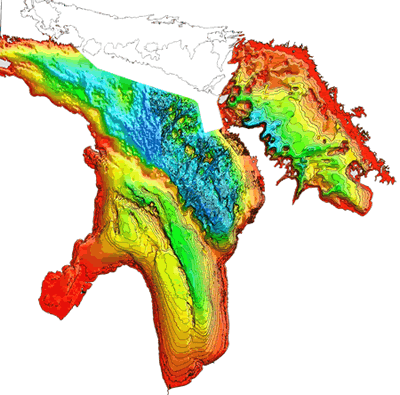
Lake Huron is the second largest of the Great Lakes and ranks as the fourth largest lake in the world.
Lake Huron Basin Statistics
| Length | 206 mi / 332 km |
| Breadth | 183 mi / 295 km |
| Depth | 195 ft / 59 m average |
| Volume | 849 cubic mi / 3,538 cubic km |
| Shoreline Length | 3,830 mi / 6,164 km (including islands) |
| Water Surface Area | 23,000 square mi / 59,565 square km |
| Surface Area in U.S. | 9,111 square mi / 23,600 square km |
| Retention/Replacement Time | 22 years |
| Outlet | St. Clair River to Lake Erie |
| Population | 1.5 million U.S. / 1.5 million Canada |
| Source: The Lake Huron Basin bathymetry map was produced by NOAA (GLERL and National Geophysical Data Center). | |
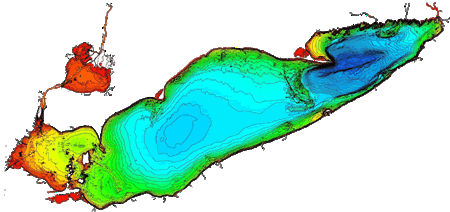
Lake Erie is the fourth largest of the Great Lakes and ranks as the 13th largest lake in the world.
Lake Erie Basin Statistics
| Length | 241 mi / 388 km |
| Breadth | 57 mi / 92 km |
| Depth | 62 ft / 19 m average |
| Volume | 116 cubic mi / 483 cubic km |
| Shoreline Length | 871 mi / 1,402 km (including islands) |
| Water Surface Area | 9,910 square mi / 25,655 square km |
| Surface Area in U.S. | 4,977 square mi / 12,893 square km |
| Retention/Replacement Time | 2.6 years |
| Outlet | Niagara River and Welland Canal |
| Population | 10.5 million U.S. / 1.9 million Canada |
| Source: The Lake Erie Basin bathymetry map was produced by NOAA (GLERL and National Geophysical Data Center). | |
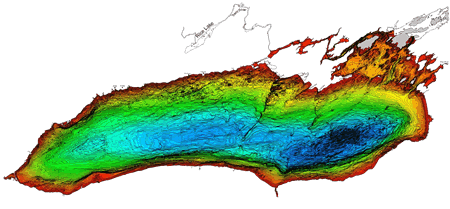
Lake Ontario is the fifth largest of the Great Lakes and ranks as the 17th largest lake in the world.
Lake Ontario Basin Statistics
| Length | 193 mi / 311 km |
| Breadth | 53 mi / 85 km |
| Depth | 283 ft / 86 m average |
| Volume | 393 cubic mi / 1,639 cubic km |
| Shoreline Length | 712 mi / 1,146 km (including islands) |
| Water Surface Area | 7,340 square mi / 19,009 square km |
| Surface Area in U.S. | 3,560 square mi / 8,960 square km |
| Retention/Replacement Time | 6 years |
| Outlet | St. Lawrence River to the Atlantic Ocean Levels regulated by international agreements |
| Population | 2.8 million U.S./2.8 million Canada |
| Source: The Lake Ontario Basin bathymetry map was produced by NOAA (GLERL and National Geophysical Data Center). |
|
Bathymetry data products, such as posters and CD-ROMs, are available to order through the NOAA National Geophysical Data Center web site.
NOAA is engaged in a program to compile Great Lakes bathymetric data and make them readily available to the public, especially to the communities concerned with Great Lakes science, pollution, coastal erosion, response to climate changes, threats to lake ecosystems, and health of the fishing industry. This program is managed by NGDC and it relies on the cooperation of NOAA/Great Lakes Environmental Research Laboratory, NOAA/National Ocean Service, the Canadian Hydrographic Service, other agencies, and academic laboratories.
Last updated: 2004-11-15 js


